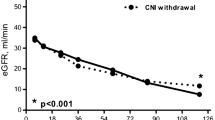Abstract
Objectives
The costs of immunosuppressive drugs in renal transplant recipients remains prohibitively high. Ketoconazole (KZ) has, in limited studies, been shown to significantly reduce the dose of cyclosporin (CyA) after renal transplantation. We report our long-term experience with the use of KZ in a large group of renal transplant recipients. Although this study was not a formal health economic assessment, we undertook a cost-saving analysis of the CyA–KZ combination usage.
Methods
The 170 patients (174 transplants) undergoing renal transplantation between 1991 and 1997 included in the study received CyA (10 mg/kg/day), prednisone (30 mg/day) and azathioprine (100 mg/day) in the immediate perioperative period. At 1 month post-transplantation, KZ (100 mg twice daily) was added and the CyA dose reduced to 25% and the prednisone dose to 50%. The CyA dose was adjusted to maintain trough levels of 150–200 ng/ml.
Results
There was an 85% reduction in the dose of CyA. The average costs were £10.61 (pounds sterling) for CyA alone compared with £2.26 (pounds sterling) for the CyA-KZ combination, which represents an average savings of £8.35 (pounds sterling) (79%) per patient per day. The estimated savings during the study period was £999,930. The patient and graft survival for patients receiving KZ was similar to patients on the South African Dialysis and Transplant Registry. Graft survival was significantly worse in black patients.
Conclusion
The use of KZ with CyA in renal transplant recipients with stable allograft function results in a significant reduction in the dose of CyA and a significant cost savings, without compromising patient or graft survival. The regimen may be useful in countries with limited resources.





Similar content being viewed by others
References
Odocha O, Kelly B, Trimble S, Murigande C, Toussaint RM, Callender CO (1996) Cost-containment strategies in transplantation: the utility of cyclosporine-ketoconazole combination therapy. Transplant Proc 28:907–909
Foradori A, Mezzano S, Videla C, Pefaur J, Elberg A (1998) Modification of the pharmacokinetics of cyclosporine A and metabolites by the concomitant use of neoral and diltiazem or ketoconazole in stable adult kidney transplants. Transplant Proc 30:1685–1687
Sorenson AL, Lovdahl M, Hewitt JM, Granger DK, Almond PS, Russlie HQ et al (1994) Effects of ketoconazole on cyclosporine metabolism in renal allograft recipients. Transplant Proc 26:2822
First MR, Schroeder TJ, Michael A, Hariharan S, Weiskittel P, Wesley Alexander J (1993) Cyclosporine-ketoconazole interaction. Transplantation 55:1000–1004
Patton PR, Brunson ME, Pfaff WW, Howard RJ, Peterson JC, Ramos EL et al (1994) A preliminary report of diltiazem and ketoconazole. Transplantation 57:889–892
Watanabe T, Gao ZH, Shinozuka N, Schulick RD, Kuo A, Burdick JF (1997) Unexpectedly low immunocompetence in transplant patients on ketoconazole. (1997) Clin Transplant 11:599–603
Wolfe RA, Ashby VB, Milford EL, Ojo AO, Ettenger RE, Agodoa LYC et al (1999) Comparison of mortality in all patients on dialysis, patients on dialysis awaiting transplantation, and recipients of a first cadaveric transplant. New Engl J Med 341:1725–1730
NIH (1999) United States Renal Data System USRDS 1999 annual data report. National Institutes of Health, Bethesda, Md, pp 73–1112
Hariharan S, Schroeder TJ, First MR (1993) Effect of race on renal transplant outcome. Clin Transplant 7:235–239
Isaacs RB, Nock SL, Spencer CE (1999) Racial disparities in renal outcomes. Am J Kidney Dis 34:706–712
Rozon-Solomon M, Burrows L (1999) ‘Tis better to receive than to give: the relative failure of the African-American community to provide organs for transplantation. Mt Sinai J Med 66:273–276
Ward FE, MacQueen JM (1996) Immunogenetic factors that may contribute to ethnic differences in renal allograft survival. Clin Transplant 10:620–624
Morris PJ, Johnson RJ, Fuggle SV, Belger MA, Briggs JD (1999) Analysis of factors that affect outcome of primary cadaveric renal transplantation in the UK. Lancet 354:1147–1152
Author information
Authors and Affiliations
Corresponding author
Rights and permissions
About this article
Cite this article
Gerntholtz, T., Pascoe, M.D., Botha, J.F. et al. The use of a cyclosporin–ketoconazole combination: making renal transplantation affordable in developing countries. Eur J Clin Pharmacol 60, 143–148 (2004). https://doi.org/10.1007/s00228-004-0745-0
Received:
Accepted:
Published:
Issue Date:
DOI: https://doi.org/10.1007/s00228-004-0745-0




